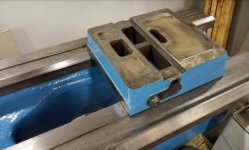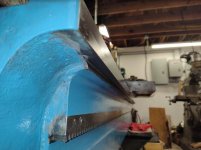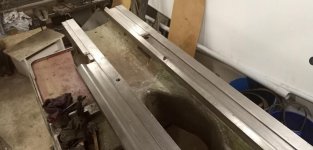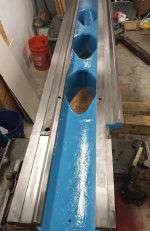Harry thought that getting the geometry was a big part of the challenge, so the other thing I think may be interesting to add to the mix is a reference straight edge and a couple of dial indicators. Lets say you bolted a true straight edge in place of the bed rack, not necessarily exactly parallel to the ways but close enough not to go out of indicator range. Then make a sled with three indicators, one on the true straight edge. Run two more indicators, one on any one front way and anther one on any back way. If you tabulate all three indicators as you go down the bed length, you'd get a good idea of bed geometry. Even if the true straight edge is off parallel by .010 over the length of the bed, you know at 1/2 the length of the bed it is off by .005", etc.
Now, if you can use that same sled to hold the grinder, you know how much to grind off along each line you've ran an indicator. I've even thought about adding a indicator before and after the grinder to see if you could determine how much the grinder was taking off in a pass. This might allow you to compensate for wheel wear? Could you couple that with a stepper motor and controller that had the geometry needed? ...
I'm not nearly as good as Harry. Nor do I have the skill set of Richard King or Forrest Addy. But lets say we set more modest goals. I don't need to split tenths of a thou the length of the bed. Lets say carriage ways, outer flat at its worst wear point is low .006". The inner edge of bed's carriage vee way low spot is .008", with outer surface of that vee way's lowest spot at .002".
Now lets say tails stock ways are much closer to acurate. On a Monarch, the carriage should not ride on tail stock flat, but because its machined very close to touching, misc debris trapped under carriage may have caused some TS flat way wear. But all in all, TS ways should be real close to true, better than carriage ways anyhow. Maybe TS flat way out by .002".
Again with more modest goals, I think you could cut the low spots in carriage ways in half, maybe even better than that, Let's say my real goal is to get carriage ways to .001" to .002". For me I would call that a huge success.
So we are looking at 3 surfaces on bed for carriage ways. One flat, and two surfaces on vee way. Treat all 3 surfaces like its own flat way. All 3 surfaces should be close to perfect at each extreme end of the bed, let's say the first and last 6" of the bed. Also the TS base is pretty stout. Maybe hand scrape TS base first, get it nice and firm to ways.

Using that base, maybe build a bridge across it. As you stated, I want multiple indicators. While I have not measured off it yet, underside of each way, the bed has been ground. How accurate to ways I'm not sure, but a potential reference, also might use it to support/add stability to bridge across TS base:

My first goal for the bed and using indicators would be to know I could tram back and forth consistently. Start at head stock end and indicate off un-wore, first 6" of way. Set indicator to zero. Tram to far end. I want to see zero at last 6" of TS end. Then tram back to head stock end. Again I want to see zero on indicator on return tram. If I can consistently tram back and forth, and always return to zero, then I think I can tram a grinder.
Use outer diameter of grinding wheel, just like a surface grinder. I wouldn't worry too much about grinding wheel wear. Your first main passes will be to lower the good/un-wore portion of ways to the lowest wear point of damaged way sections. With your final passes sparking out, just barely kissing the surface. Prior to hitting power button on the grinder, you could run test trams back and forth to ensure wheel is the same clearance on both extreme ends of bed.
Go nice and easy on each grinding pass, cutting between .00025" to .0005". Gradually working down to the valley of the worst wear. Set up to use electric wire cable hoists to pull tram both directions.
I would want to keep track of how much material removed. But in my head its almost irrelevant. Its a given the bed has wear, the carriage has
more wear. So the carriage will have to be raised. But we don't know the number of how much it needs to raised. We wont know that number until ways are cut, and. . . with saddle, apron, lead screw etc mounted. We can shim/feeler gauge up the carriage until lead screw is centered in apron. And with those feeler gauge numbers, we have a real good number of what to add to raise carriage.
The real key is being able to tram consistently and stable. If I can, I feel absolutely confident I can make improvement over current way wear. Will I be splitting tenths of a thou, probably no. But I'd bet you a dollar I could get inside .001-002" over a substancial length.




 . Do you think its too hard to grind ?
. Do you think its too hard to grind ?
